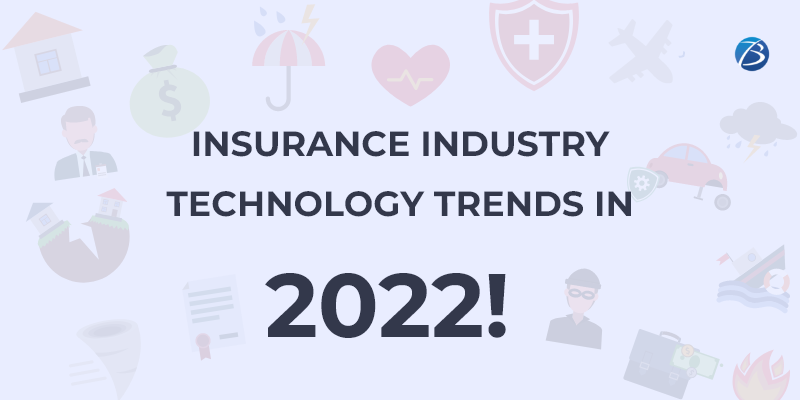Noteworthy Technology Trends that are Revolutionizing the Insurance Industry in 2022

The past two years have been a testing time for insurance providers as they have encountered endless challenges in offering services to customers during the Covid19 pandemic. Moreover, insurance companies faced tough competition from peers to provide a digital-friendly customer experience that involves quicker services and lesser hassles and handles operational bottlenecks. To encounter the tough challenges, insurance sector has transformed a great deal; a sea of novel and innovative approaches has been adopted and a plethora of emerging technologies have been leveraged.
Let’s take a sneak peek into the most noteworthy technology trends that are disrupting the insurance industry landscape in 2022.

Embedded Insurance via open APIs
Embedded Insurance, enabled via open APIs, is a common insurance industry trend these days. Here, consumers are offered an event-triggered insurance coverage or protection when they purchase a third-party product or a service. In other words, insurance offers are weaved directly into the purchase deal at the right moment when the consumers are most likely to buy the coverage. For example, consumers get an option to opt for extended protection/warranty when buying a cell phone device, travel insurance while flight ticket booking, coverage for newly purchased appliances, and so on.
Insurance providers utilize open APIs to showcase their services to customers while external business partners make use of such insurance coverage offers for providing a value-added deal to their consumers. This way, business enterprises are connected using APIs to form an entire insurance ecosystem that ensures an elevated UX for customers.
The main objective of embedded insurance is to provide customers with customized and affordable insurance when there is an urgent need for it. Sometimes, customers are not even aware of the need for insurance cover until they are offered one.
Thus, the embedded insurance approach is beneficial for insurance companies, third-party service providers as well as consumers. For instance, an auto insurance provider can partner with a car dealer for selling insurance using the car dealer’s app. Customers also enjoy the convenience of purchasing a car and the much-needed insurance policy at the same time, without having to look for it separately.
Accelerated Underwriting and Automated Underwriting
Underwriting is a hassle-prone and time-consuming process that all individuals applying for insurance coverage policies need to undergo. Applicants need to provide a host of documents confirming their personal information, lifestyle, and medical records. This process is conducted for determining whether the applicant is insurable or not; and if so, what amount is that person entitled to as per his/her risk profile. Applicants with increased mortality risks need to pay higher insurance fees. Accelerated underwriting and automated underwriting are trending techniques that aim to make the underwriting process easier and speedier.
Accelerated underwriting, a trend that has gathered momentum during the pandemic outbreak, simplifies the underwriting process for consumers by employing ML algorithms and predictive analysis. Using this approach, qualified insurance applicants do not need to undergo medical tests or furnish a written statement from a doctor mentioning their medical history, or attach copies of their healthcare records. The removal of these steps has not only minimized waiting times for applicants but has also reduced policy costs and accelerated sales.
Coming to automated underwriting, advanced technologies like AI and RPA are being used for automating the repetitive tasks in the underwriting workflow of an insurance firm. Therefore, all relevant information needed by underwriters is available in a single place, resulting in a speedy and more informed decision-making process. This approach is immensely beneficial to underwriters in handling complicated quotes and binding processes.
Healthcare Wearable Devices
The usage of wearable devices in the healthcare industry is not new. Now, insurance companies have also started reaping the benefits of wearable technology. Insurance providers are linking their products with wearable devices for monitoring policyholders’ sleep patterns, daily steps, activity levels, oxygen levels, temperature, heart rate, etc. This information obtained from wearables is used for creating personalized health plans and rewarding policyholders for healthy lifestyles. The health and risk scores calculated using this data can be utilized for providing complimentary coverage, benefits, or better rates to an individual as well as corporate policyholders.
Improved Benchmarking and Modeling with Predictive Analysis
Predictive analysis is one of the most interesting insurance industry trends today. Historical data is collected and fed into AI-trained models for generating predictive data on the behavioral patterns and ongoing trends. Predictive analysis helps insurance agencies make more informed decisions on how to optimize workflows and execute tasks like quoting, recommending products to customers, etc. This particularly facilitates sales and underwriting.
Take a look at how these tasks are carried out. The usage of artificial intelligence for generating and recommending an alternative quote adds value to the process, reducing the chances of errors, and also minimizes guesswork. Machine learning algorithms process synthetic data and help insurers to identify the most popular plans amongst customers from specific demographic groups or industrial domains. As such, the decision-making process becomes easier and better.
Chatbots
The usage of AI/ML-driven chatbots for providing customer services is another noteworthy insurance industry trend. Chatbots are virtual assistant solutions that interact with consumers seamlessly through text messaging or voice messaging. Chatbots solve customer queries on insurance, provide them the relevant information on policies, and offer 24X7 services without the need for human interventions. Virtual assistants can even guide a customer all through the processes of insurance policy application and claims processing. Just like a human insurance agent, chatbot questions customers on their requirements and personal details needed for the policy. Based on this data, these chatbots recommend personalized policies, assist customers to compare different policies, and solve follow-up questions helping them to gain a better understanding of their policy.
Blockchain Smart Contracts
The usage of Blockchain Smart Contracts is a crucial insurance industry trend that comes with endless advantages. Today, several insurers are issuing policies to customers via Blockchain Smart Contracts and healthcare records encryptions. Such an approach not only establishes transparency between the insurance providers and policyholders but also enhances the efficiency and security quotient of insurance processes. Let’s take a closer look!
Smart contracts eliminate the need for mediators, speed up claims processing tasks, zero down the need for human interference, reduce the risk of manipulations as no mediators are involved, and securely stores data without the risk of being lost or stolen. Therefore, it becomes possible for insurance providers to lower the premium amount, thereby increasing their market share considerably.
Moreover, smart contracts enable insurers to review the data regarding the previous insurance policies and claims, allowing them to provide more precise cost pricing options for their products. This way, the quality and effectiveness of underwriting programs expedite.
Blockchain implementation also contributes greatly to lowering operational and infrastructural costs through automating servicing tasks and preventing fraudulent practices.
Drones for Risk Inspection
Drones are being leveraged by insurance providers to improve the efficiency of certain processes within the insurance lifecycle. Drones assist in preventive maintenance, collect data for calculating the risk factors before a policy is issued, and examine the amount of damage after a loss. Drones can perform tasks that their human counterparts can never think of achieving. Robots can effortlessly enter enclosed and perilous spaces for collecting data and their 360-degree cameras increase the efficiency of the process to a great extent. Moreover, one drone can gather data much faster and more effectively than a team of human surveyors. Examples of drone usage include gathering data on buildings, conducting roof inspections, etc.
Telematics
Telematics technology is another eye-catching insurance industry trend. It helps car insurance firms provide customers customized discounts and insurance policies based on actual usage, and identify falsified or fraudulent claims.
Here’s an example of Telematics implementation in automobile insurance. Cars can be embedded with monitoring devices that record information on the car’s current location speed, accident occurrences, etc. This data is processed using advanced analytics software for determining the premium amount and assessing the genuineness of claims. Whenever a policyholder files a claim for an accident or injuries, the auto insurers collect information from the black box telematics of the vehicle. This helps to figure out the actual incident that happened. This way, insurance companies can identify falsified claims and hence, save a great deal of money wasted on fraudulent claims.
Extended Reality
Extended Reality, also known as XR, is one of the newest and most disruptive insurance industry trends. Extended Reality employs a combination of Virtual Reality, Augmented Reality, and Mixed Reality for collecting more environmental information and enabling unthinkable experiences via AI.
XR is a great tool for insurers for promoting employee and customer engagement. This technology can create virtual customers for training customer service teams. It can train them on client interactions and the policy purchasing process. Moreover, augmented imagery allows insurance providers to remotely communicate with customers. Furthermore, underwriters can create XR simulations using illustrations and on-site images for assessing the risk factors in buildings accurately. Some insurers are also offering a 3D-simulated eco-system to consumers via VR headsets. Here, customers interact with the avatar of insurance experts for understanding insurance processes and resolving queries.
Over to You:
The aforementioned trends are game-changers that are set to redefine insurance sector operations. Smart digital tools and strategies are allowing insurance companies to provide elevated customer experiences and streamline service operations like never before. The most lucrative outcomes include offering convenience to customers in buying insurance, providing easy access to the desired information, and reaching out to customers when they need insurance services/products.
So, it’s high time for insurance companies to embrace a technological approach! However many insurers who are not tech-savvy are reluctant to smarten their operations due to the complexity of implementing and maintaining technological approaches. Well, in such cases, it’s advisable to seek technical assistance from experienced Software Development Company that will be your partner throughout the product development lifecycle.
Other articles and publications:
Articles and publications of other companies:
- +1 (469) 277-0804
- 8305 Tripoli Trl, Frisco, TX 75034, United States
- www.biz4solutions.com/













